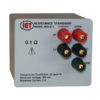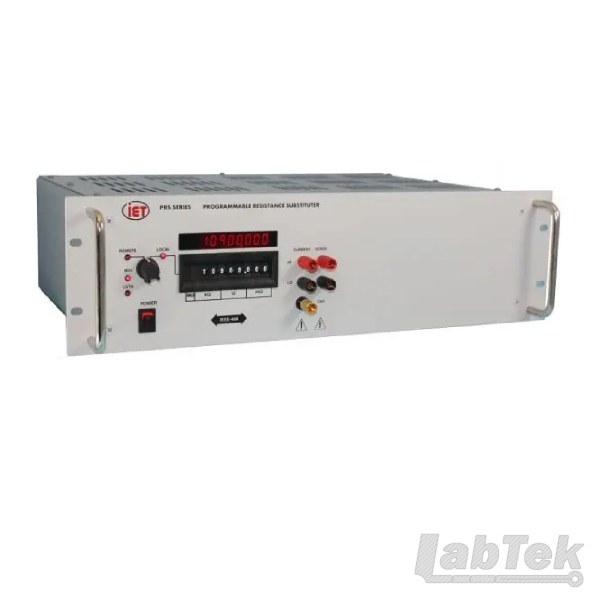A broad range of programmable resistance decade boxes for applications requiring a programmable impedance unit, controlled manually and by a computer via an IEEE-488, RS-232 or Ethernet interface.
The PRS Series is a broad line of high programmable decade boxes. They provide direct resistance substitution as well as RTD (Resistance Temperature Detector) simulation, in a wide selection of ranges, tolerances and ratings.
The PRS programmable resistance decade box is a precision resistance source with excellent characteristics of stability, temperature coefficient, and power coefficient. High dynamic ranges are available, starting as low as 1 mΩ, and extending to as many as 10 decades. These features combined with a low virtually constant zero resistance make for very versatile instruments.
The PRS Series programmable resistance decade box features two optional special settings. An “open circuit” and a “short circuit”. These modes are useful for obtaining reproducible transitions between settings, i.e. break-before-make or to short between settings. The “short circuit”: setting also provides a reduced zero resistance.
Operation is both local using convenient direct-reading front panel thumbwheel switches, and remote with optional Ethernet, RS-232, or IEEE-488 interfaces.
Both can provide an optional extra “10” position for each decade.
The PRS Series programmable resistance decade box employs very low resistance, low thermal emf relays with gold-clad silver-alloy contacts. A special design keeps contact resistance to a minimum. The gold plating keeps the silver contacts from becoming tarnished when unused, or when only low currents are passed through them. This is most often the case when only minute test currents are drawn by digital multimeters and other test instruments. Contact resistance remains low and repeatable.
The programmable decade box employees, high-quality gold-plated tellurium-copper five-way binding posts serve to minimize the thermal emf effects, which would produce errors in dc resistance measurements. All other conductors within the instrument, as well as the solder employed contain no metals or junctions that could contribute to thermal emf problems.
With a resolution as low as 1 mΩ and a maximum available resistance of over 100 MΩ, the PRS Series Series may be used for exacting precision measurement
applications requiring high accuracy, good stability, and low zero resistance. They are suited for automatic and manual calibration and testing, simulation of RTD’S, programmable loads, and many other laboratory and industrial applications. The PRS Series programmable resistance decade box may be rack mounted to serve as components in measurement and control systems.
PRTD Version: Low resistance versions with a fixed minimum resistance setting (4 Ω or specified by customer) are suitable for Programmable RTD (Resistance Temperature Detector) simulations. This design virtually eliminates the effect of zero resistance and relay contact resistance, providing the specified absolute accuracy over its entire range.
DRIVERS – TEST KEYBOARD
To aid the user in operating the PRS/PCS/PLS, Three “Keyboard” Controller programs – the easiest way to control GPIB, RS232 or Ethernet devices without writing a program – are available from IET. This Keyboard programs automatically finds your device at start-up and it lets you enter just the data that you want to send to the device. This program works with ICS, Measurement Computing and National Instruments GPIB controllers.
For GPIB IEEE-488.1 and IEEE-488.2 interface
Download ICS_GPIBkybd_Install.zip
Unzip the file and follow instructions to install. Open the application. You may use the Find Listeners button to confirm that the PRS unit is recognized. Other instruments may also be recognized at this time.
Enter and set the Address to the PRS address. Use the window to send a command string to the PRS, where the command string is constructed as described in the operating manual. A command string might be, for example:
SOURce:DATA resistance string
For Serial RS-232 interface for Windows XP:
Download: ICS_Serkybd_Install.zip
Unzip the file and follow instructions to install. Open the application. Initialize the COM PORT and use the Device Command window to send a command string to the PRS, where the command string is constructed as described in the operating manual. A command string might be, for example:
SOURce:DATA resistance string
?
For Serial RS-232 interface for Windows 7 and later operating systems.
Download: Serkybd.net.zip
Unzip the file and follow instructions to install. Open the application. Initialize the COM PORT and use the Device Command window to send a command string to the PRS, where the command string is constructed as described in the operating manual. A command string might be, for example:
SOURce:DATA resistance string
?
A VB.NET 2005 version of the Serkybd program for Windows 7 and later operating systems. COM Port range expanded from 1 to 12 for USB-to-Serial Adapters. For Ethernet interface:
Download: ICS_VXI-11.zip
Unzip the file and follow instructions to install. The application allows the user to change IP address and communicate with the PRS. Please see PRS instruction manual for more information.
?


